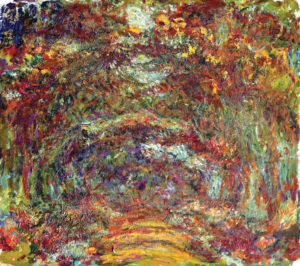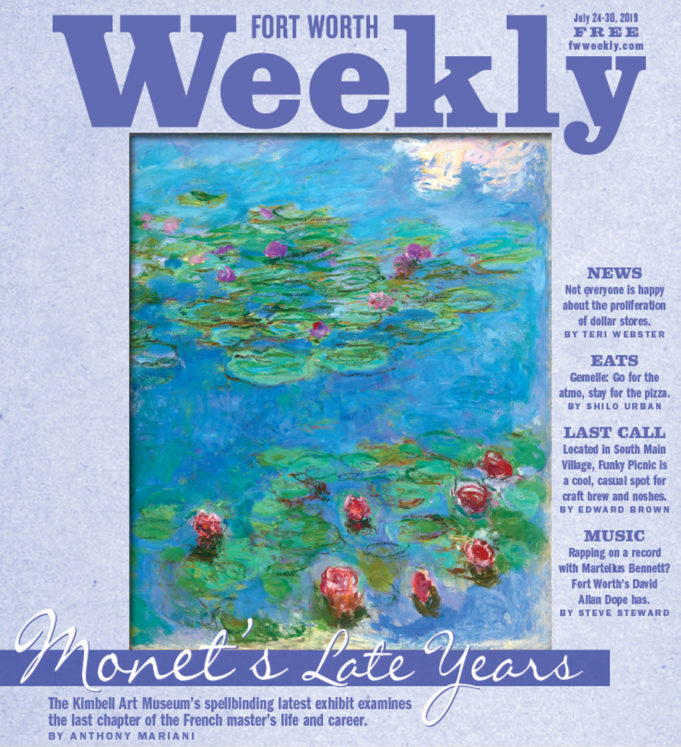Potential theory: Monet was obsessive-compulsive.
Nothing else explains how or why the legendary Impressionist spent just about every day of his latter years painting the same few objects in the backyard of his expansive estate in France.
In the first exhibition in more than two decades devoted to the final chapter of Monet’s career (1913 until his death at the age of 86 in 1926), Monet: The Late Years proves that he was obsessed with (in order of significance): water lilies, a Japanese footbridge, his house as seen from a nearby rose garden, and a willow tree. The exhibit features several variations of each. There are 52 paintings in total. A little more than half of them are of water lilies.

Hanging now through September, the exhibit is a slow, eventually satisfying burn. Amid the delicious, brilliantly hued impasto, the early inklings of abstract-expressionism begin to bloom, which, while perhaps hard to prove beyond a reasonable doubt, has historical antecedents – more than a few early ab-ex pioneers were influenced by Monet. Last year, The Musée de l’Orangerie in Paris put on The Water Lilies: American Abstract Painting and the last Monet, a juxtaposition of 10 Monets with 20 pieces by marquee Americans of the post-World War II era. With his focus on tableaux that lend themselves to the now-geometric, now-amorphous content of everyone from Mark Rothko and Jackson Pollock to Barnett Newman and Ellsworth Kelly, the show lurches forward into the Instagrammable now, lolling through the subtleties of primitivism and the bold hues of fauvism and expressionism into the controlled chaos of our fractured, blurry, contemporized selves.
Organized by the Kimbell and the Fine Arts Museums of San Francisco and drawing from public and private collections in the United States, Europe, and Asia, Monet: The Late Years follows Monet: The Early Years, the 2016-17 Kimbell exhibit focused on the artist’s pre-Impressionist years, when his work was a little more traditionally representational. Monet: The Late Years, featuring several pieces that have never before been seen in the United States, is like a minimalist dirge: It rewards patient and total immersion.
To the easily distractable or people in a hurry, Monet: The Late Years may appear a little redundant. However, anyone willing (or able) to chill a little (and put their phone away) will see new ideas about visual, prismatic harmonizing and the dignity and dereliction of Mother Nature. Monet’s painterly obsessions date back to his earliest work. It could be that he returned to them because he had experienced devastating loss, the deaths of his second wife and eldest son, and because he was losing his eyesight. Or it simply could be that Monet could not travel. The drums of war were pounding. The expansive garden on his estate of Giverny saw him broaden his brushstrokes and experiment with dynamic combinations of color, which resulted in a new, almost postmodern kind of Monet.
And also a bigger one. Upon the construction of a massive studio at Giverny in 1916, the artist began to tackle larger canvases, many measuring between 14 and 20 feet wide. The jewel of this new arrangement was a series of mural-style paintings. Though the actual Grandes Décorations – essentially, a circular room where the viewer is surrounded by one long, forever curving painting of water lilies – cannot be removed from l’Orangerie, studies await at the Kimbell. They are all part of his oeuvre. As his eyesight deteriorated, Monet returned to smaller canvases. A lot of them. The Kimbell argues that their sheer number parallels the sheer size of Grandes Décorations.
As the exhibit is laid out thematically, the final gallery, cast mostly in shadow and punctuated by a short black-and-white film of Monet at work at Giverny, is a little spooky. It was at this time period when the artist had to memorize the colors of paint on his palette. The final gallery is also the most abstract-expressionist. What’s really brought to life by the mercurial, thick brushstrokes is the feeling that you’re in the room with Monet as he’s painting. You can really sense him, all these years later. It’s as close to time traveling as any viewer is ever going to get.
As radical as Monet’s late works had become, the “impressive yet fragile deity of the Seine,” as one visitor called him, saw them as merely a continuation of his love affair with nature. He was just as awestruck by natural beauty in his 80s as he was when he first started out.
“My sensitivity,” Monet said, “far from diminishing, has been sharpened by age, which holds no fears for me so long as unbroken communication with the outside world continues to fuel my curiosity, so long as my hand remains a ready and faithful interpreter of my perception.”
Monet: The Late Years
Thru Sep 15 at the Kimbell Art Museum, 3333 Camp Bowie Blvd, FW. Free-$18.
817-332-8451.












